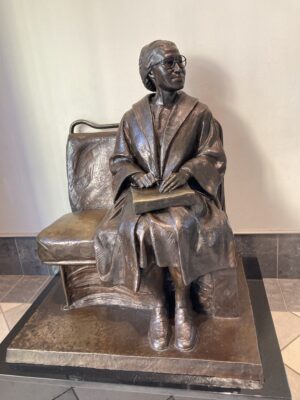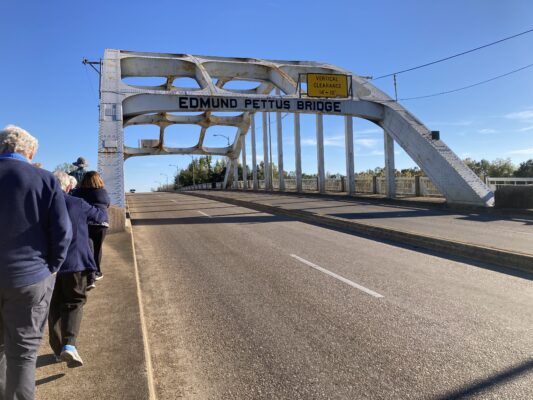Since reading Just Mercy: A Story of Justice and Redemption, by Bryan Stevenson, published in 2014, I became interested in his work as an attorney and social justice advocate, and as a result, a supporter of his Equal Justice Initiative in Montgomery. When he opened the National Memorial for Peace and Justice, and The Legacy Museum: From Enslavement to Mass Incarceration, I knew I wanted to visit. This pilgrimage includes those two sites as well as numerous other landmarks in the struggle for Black Civil Rights.
The Pilgrimage is a packed four-and-a-half days of immersion in the Civil Rights Movement beginning in Birmingham, historically a racially divided city. We know about the numerous restrictions imposed on the lives of Black Americans: students were prevented from attending high school; their parents did not have the right to vote; families could not live where they wanted; Black and white children were required to play separately, two blocks away from each other, to ensure there was no mixing of the races; Black people were prohibited from using the same toilets and water fountains as whites; they had to use separate entrances to public buildings; they could not be treated at white hospitals; they were required to sit in the backs of busses; Black men were only permitted to work at hard labor jobs like mining for long hours and terrible pay.


Beginning in 1953 at Bethel Baptist Church, the seeds of change were planted by Pastor Fred Shuttlesworth, an outspoken and fiery orator, who urged his congregants to fight segregation and advocate for civil rights, education, voting rights and employment. Toward that end, he organized the Alabama Christian Movement for Human Rights which spread to 60 Birmingham churches and later joined with the Southern Christian Leadership Conference under the leadership of Dr. Martin Luther King, Jr. Reverend Shuttlesworth survived multiple bombings and beatings while practicing non-violence. The city was nicknamed “Bombingham.” We attend a Sunday church service at the new Bethel Baptist Church where the local congregation welcomes us kindly.

In Montgomery, the state’s capital, in 1955, Rosa Parks refused to give up her seat in the whites-only front of the bus. A planned one-day bus boycott lasted 13 months, Black workers walking miles every day to and from their places of employment, until a US Supreme Court decision in 1956 overturned segregated transportation. We visit the Rosa Parks Museum, dedicated to her contributions.

On September 15, 1963, at the First Baptist Church in downtown Birmingham, the Ku Klux Klan planted a bomb in the church basement killing 4 young black girls, a horrific event that finally gained the attention of people all over the United States. We spend time walking through Kelly Ingram Park, just across the street from the Church, where there are sculptures and signs dedicated to the struggles of Black Americans to gain their freedom.



On March 7, 1965, the Civil Rights March that became known as “Bloody Sunday,” Hosea Williams and John Lewis led 600 marchers, attempting to cross the Edmund Pettus bridge in Selma on their 54 mile march to Montgomery. They were violently stopped by state and local lawmen, who attacked the unarmed protesters with billy clubs and tear gas. This led to the passage of the Voting Rights Act of 1965 signed by President Lyndon Johnson. We walk across the bridge in silence contemplating what happened here.




We learn about four people who were martyred in the struggle for freedom: Jimmy Lee Jackson, a young Black man trying to protect his mother, murdered by police in the Marion Civil Rights March in February 1965. This event was the impetus for the Selma to Montgomery March; Viola Liuzzo, a 35-year-old white woman, mother of five, who supported the Civil Rights Movement and drove from her home in Detroit to help shuttle marchers to Selma, shot and killed by members of the Ku Klux Klan. The murderers were arrested and tried but not convicted; Jonathan Daniels, a white Seminarian, working on the Voting Rights campaign who picketed a white owner’s store and was arrested, held for 6 days, released and then shot; and Reverend James Reeb, a white social worker, father of four, who came from the Northeast to support the Civil Rights Movement, severely beaten in Selma by a white mob after Bloody Sunday, dying two days later.


We hear from some local people about their touching remembrances. In Montgomery, we visit the Parsonage where Dr. King was the resident Pastor of Dexter Baptist Church from 1954-1960. The docent, now a 75-year-old woman who had been a young girl at the time, spoke lovingly of her memories of a warm and kind Dr. King. In Selma, a local historian and school teacher of 38 years, who as a 15-year-old was called to join the 1965 March, remembered a long-ago kiss she received on her cheek from Dr. King.
The Legacy Museum founded by Bryan Stevenson, provides a remarkable and comprehensive history of Black Enslavement, Segregation, the Civil Rights Movement, and Mass Incarceration. We spend several hours there, not nearly enough time, to comprehend and digest the horrors and indignities Black American citizens suffered and still suffer, as a result of the laws and behavior of white American people. I am filled with admiration for the bravery, dignity, and commitment the activists demonstrated in sacrificing their safety and sometimes their lives to gain their Civil Rights. No photos are permitted inside the Museum.

The National Memorial for Peace and Justice commemorates four thousand Black Americans who were lynched in fourteen of the United States. Each martyr is represented by a hanging sculpture with names, dates, and locations of their murders. Nearby placards describe the circumstances in which the killings took place and often, the large crowds that observed. These are chilling.







Today, Selma is underserved. The population at 17,000, is diminished by half. Buildings and storefronts are empty. Selma has done so much for this country and America has abandoned it.
Every American should know the history of the Black Civil Rights Movement that continues to this day.


2 Comments
What an educational trip! So much depth to learning about the terrible treatment of our black citizens. Humbling.
What an emotional journey.